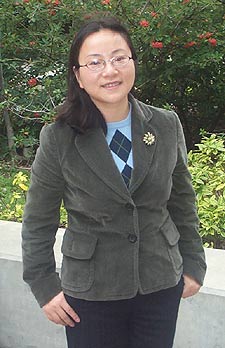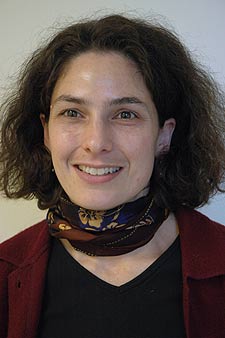Berkeleyan
Berkeley’s 2004-05 curricular cohort
10 November 2004
One studies illegal subsistence hunting in Africa; another ponders what it is that makes distinguished female scientists reluctant to try their luck as entrepreneurs. A third delves into the contradictions that exist within American penology. And the fourth? Let’s just say that she was mightily impressed by her long-ago encounter with a salamander.
The stories of just four of this year’s 77 new Berkeley faculty members are below. For a glimpse of the other 73, visit the Office of the Vice Chancellor for Research website, which has collected profiles of these new additions to the distinguished roster of Berkeley academics.
Assistant Professor, Environmental Science, Policy & Management
 Justin Brashares (Barry Bergman photo) |
But it wasn’t until college — when he took a year off to observe African antelope in Kenya — that he found his calling. “That was where I realized, okay, this is really what makes me happy,” says Brashares. “I just really loved it.”
That discovery led to a career as a conservation biologist, and ultimately to Berkeley, where he’s now an assistant professor of ecosystem sciences in the College of Natural Resources. With the change in habitat — he received his Ph.D. from the University of British Columbia, and did postdoctoral research at the University of Cambridge — have come new pressures.
“One of the life-saving things that happened pretty early on is that several of us new faculty members kind of banded together and cried on each other’s shoulders,” says Brashares. “Where we worked before, the consequences of not publishing great papers were somewhat vague. Whereas here, it’s within minutes that everyone’s talking about the ‘T’ word’ — you know, what it will take to get tenure.”
Other stresses include the Bay Area housing market, “a common shoulder-crying topic,” and longer separations from his research subjects. Brashares — who typically brings along his wife and two young sons on his travels to Africa — now employs Ghanaians to do basic data collection and relies on grad students for other assistance. “A lot of being a researcher is handing the fun stuff over to other people,” he says. “I didn’t get into this so I could sit in front of a computer all day, but that’s sort of what it’s becoming.”
The academic life isn’t entirely lacking in adventure, however. This week, the journal Science will publish a paper Brashares co-authored on illegal bushmeat hunting in Ghana, and he will face the press at a news conference. For the soft-spoken ecologist, the prospect calls to mind his recent experience in Vancouver, where — in a press release on his research linking social behavior in large mammals
to extinction risks — he offered this delectable soundbite: “In avoiding extinction, it pays to be promiscuous.”
“There was a TV talk show, kind of a cable sex-talk program — all humans, obviously — that wanted me to come as a special guest and talk about whether promiscuity in people was a good idea for extending your life,” laughs Brashares. “As malleable and naïve as I was and am, I still recognized that that was a bad idea.”
— Barry Bergman
Assistant Professor, Haas School of Business
 Waverly Ding (Jonathan King photo) |
“People in the academy are changing their perceptions about commercializing their research,” says Waverly Ding, a freshly minted Ph.D. from the University of Chicago who is in her first semester on the Haas School faculty. “In the 1970s there was a widespread sense that science is not supposed to be used for profit. That attitude has changed a lot, and universities — to some extent — are willing to further that.”
In researching the various conditions that prompt life scientists in university settings to become entrepreneurs, Ding draws heavily on her background as a sociologist (she holds a master’s in that discipline from New York University). She and her mentor/collaborator, Toby Stuart of the Columbia Business School, have focused closely in their research on the “social and physical proximity” of these academics to colleagues in the commercial sphere. In many departments, she says, people who have already moved into the commercial arena serve as mentors and role models for the younger faculty who follow them.
“At the same time,” she adds, “people collaborate widely in academia, and these co-authors also exert social influence” over those faculty who most typically choose to follow an entrepreneurial path, as either principals of or senior advisers to biotech startups.
The same forces don’t apply equally in other technical sectors. In the semiconductor field, for example, the division between basic and applied scientists means that “the two camps don’t mingle much.” But in biotech, says Ding, “basic science rules: If you patent a gene sequence that comes out of your academic research, it can be used for drug development immediately. Discov-ery and application are bundled together in a way that isn’t true of the other high-tech fields.”
Ding is also researching gender differences in biotechnology. Some of her findings appear straightforward enough: “high productivity” male scientists, for example — those with numerous papers published and citations flowing therefrom — do in fact benefit in the estimation of the private sector from their reputation and prestige. Women, as it turns out, benefit from equivalent prestige to an even higher extent — thanks to a “reverse stereotype” that leads venture capitalists and others in the outside world to assess their accomplishments through a discriminatory lens. Yet, paradoxically, women from elite universities are less likely to venture into the entrepreneurial realm than are their male peers — in large part, Ding says, because they are risk-averse.
“Particularly in the early years of biotechnology, going into the private sector entailed giving up some part of your status. For a woman, if becoming a professor in an elite institution is hard, then the thought of giving it up is also hard.” The risk, she says, is of doing some form of irreparable damage to their hard-won reputations . . . an artifact, perhaps, of the belief that abandoning the academy for the business world is a move to be disdained.
— Jonathan King
Assistant Professor, History
 Rebecca McLennan (Cathy Cockrell photo) |
The young historian came of age in Wellington during the late 1970s and early ’80s — just as New Zealand was establishing closer ties with the U.S., which in turn was “on the verge of winning the Cold War, or at least becoming the dominant global power.” By a peculiar logic, then, for a young person interested in studying global history, it was a good time to, as she puts it, “come to Rome.”
At Columbia University, McLennan studied American political, diplomatic, and social history. Next she joined the faculty at Harvard, where she brought an outsider’s curiosity to the exceptional power and scope of the U.S. penal system.
“Americans think of Europe and Scandinavia as having far more interventionist governments than here in the U.S.,” she notes. But that’s only true “when comparing welfare states. In terms of penal and repressive capacity, the power of the U.S. state is exceptional on the world stage.” To cite just one statistic, she observes, “incarceration rates are six to 10 times higher here than in Europe and the British Commonwealth.”
As McLennan shows in her forthcoming book, The Crisis of Imprisonment: Protest, Politics, and the Making of American Penal State, 1865-1941 (Cambridge University Press), punishment in America has been the subject of great conflict, some of it violent, going back to the revolutionary era. The early Republic saw vigorous debate, she says, about “whether it was morally acceptable in the eyes of God to incarcerate those convicted of crimes” or whether it “was God’s prerogative, not Man’s, to try to reconstruct or cleanse souls.” Later, in the 1880s and ’90s, a mass movement of workers, farmers, and social reformers mobilized to overthrow America’s ubiquitous system of commercialized imprisonment, under which state governments sold the labor of their prisoners to private, for-profit business interests.
“What draws me to American history are the radical, critical, human-rights traditions of this country,” McLennan says. “The U.S. is wealthier, and dominates the world more effectively, than perhaps any power ever has. But it also has advanced some of the most enlightened and humanitarian causes and moral systems, building on the revolutionary idea that human beings possess certain inalienable and natural rights. That radical, democratic project of the U.S. is still very much alive, if under siege in recent years.
“There is a reactionary and conservative America, but there’s also a world-altering and revolutionary tradition of liberation. My scholarship endeavors to make sense of that dialectic.”
— Cathy Cockrell
Assistant Professor, Molecular & Cell Biology
and Integrative Biology
 Nicole King (Jeffery Kahn photo) |
Over the past several decades, the scientific community was surprised if not shocked to find that animals — from fruit flies to humans — share many of the same genes. “I wanted to see if these genes existed in single-celled organisms,” says King. “And if so, how did multicellular animals evolve from their single-celled ancestors? There is no fossil record for this
evolutionary event. For my research group, that is the challenge: We are trying to reconstruct the ancestral animal genome. Can we do this through research on living organisms?”
Much of what is known about animal cell biology has been inferred from studies on yeast. King is looking at a different model, choanoflagellates. She grimaces when her star subject is referred to as pond scum, but acknowledges that these primitive ancestors of the sponge indeed do enjoy pond living. And they share something with humans and other animals. King discovered that choanoflagellates have many animal-type genes never previously seen in a non-animal. Genes that control the functions of cell adhesion and cell communication — two fundamental aspects of multi-cellular animals — emerged in this simple grandparent organism.
King was born in Gainesville, Fla., the daughter of a professor of history. A middle-school teacher and a salamander science project hooked her on science, and she did her life-sciences undergraduate work at Indiana University. At Harvard she earned a Ph.D. in biochemistry and then, in 2000, began a three-year postdoc program in evo-devo at the University of Wisconsin. Her lab, part of the Center for Integrative Genomics, is funded by the Gordon and Betty Moore Foundation.
The young professor relishes both teaching and her students, and two undergraduates work in her lab. Says King: “I taught as an undergrad and stayed an extra year at Harvard to teach. The students here at Berkeley are the best I have encountered. They work hard and challenge me with their questions, and I learn as much from them as they do from me.”
— Jeffery Kahn

